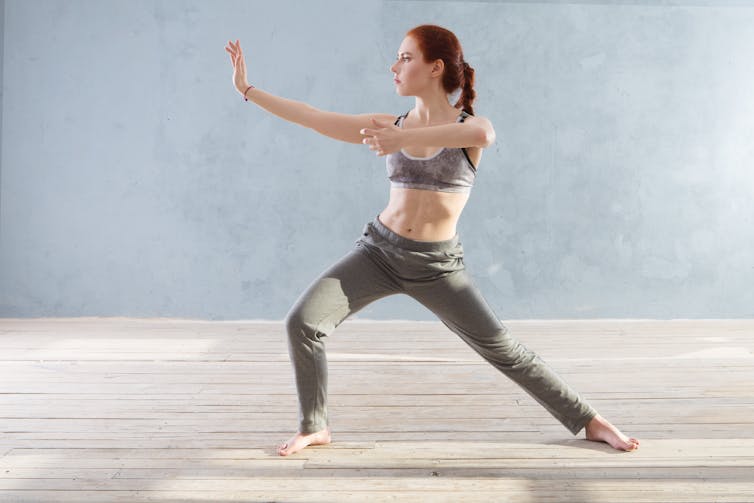Meditation has been hailed as a way to boost mental health, help chronic pain, reduce stress and build a new appreciation for the world around us.
But even with all this interest, misconceptions about what this ancient practice can do for human health and well-being are still circulating.
1. There is only one type of meditation
Only some meditations involve sitting quietly with legs crossed. Qi Gong and Tai Chi, for example, focus on meditative movement. This combines a relaxed but alert state of mind with slow movements and gentle breathing. Others, like Tibetan Buddhist meditation involve visualisations and/or mantras. There is also “thinking meditation” where one reflects on topics such as impermanence, while staying relaxed yet focused and reflective.
Many types also encourage bringing meditation into ordinary daily activities – such as mindful dish washing involving paying attention to the sensations of the water and hand movements. Similarly, there is eating meditation, where one expresses gratitude for the food and wishes for others less fortunate.
2. It’s all about being still and quiet
Stable non-reactive attention is developed in all meditation types, but it is particularly targeted in mindfulness practices. Other meditation types cultivate qualities such as compassion, generosity or forgiveness. Another form – sometimes called deconstructive meditation – specifically develops contemplative insight into the working and nature of our minds.

Meditation training typically progresses from practices which stabilise attention to cultivating compassion and other related qualities, then insight. Importantly, at each of these stages the meditator reflects on their motivation and intentions for the practice, which is likely to affect the outcomes too. While some may meditate to reduce anxiety or back pain, others seek spiritual awakening, for example.
3. You have to be able to “empty the mind”
While meditating does often involve quieting of the mind, this doesn’t mean the mind goes blank. Meditation involves developing the ability to observe one’s thoughts, emotions and sensations with the quality of non-reactivity – that is being able to notice and pause rather than react – and develop a wider compassionate perspective.
The idea that one needs to empty the mind has probably come from misunderstandings about some advanced meditation types such as meditative absorptions, awareness of awareness practices or some Dzogchen meditations. These are accompanied by very few ordinary thoughts, sensations and emotions. But even with limited thinking, these meditative states have qualities of ease, clarity, compassion, alertness and reflective awareness. Forcefully trying to limit thinking would be unhealthy at any stage of meditation training.
4. Meditation will put you at ease from day one
Meditation isn’t simply a smooth ride to a quiet mind. Increased awareness of unhealthy mental habits and behaviour is common at the beginning of practice, and during transitions towards more advanced stages of meditation. These challenging experiences can actually give rise to some adverse effects – such as increased anxiety or disorientation. This is why it is important to practice under the guidance of an experienced and qualified meditation teacher who is able to provide advice on how to work with such experiences.
5. We know all there is to know about the benefits
Research has already supported the benefits of some types of meditation on things like depression and to some extent stress reduction. However, some other common claims aren’t backed up by scientific research. There is mixed or insufficient evidence on the effects of meditation on reduction in stress hormone levels, for example, and on ageing too.
Though research into how meditation affects the human brain continues, at present our understanding of the long-term effects of meditation is very limited. Most studies tend to follow the effects of meditation from before to after an eight-week course, or one-month retreat, rather than years or potentially a lifetime of meditation.
Neither have the benefits been defined by type of meditation. Different meditation styles – and even different types of mindfulness – have different forms and aims and so might have different impacts on human psychology and physiology.
6. It is only for reducing pain, stress or anxiety
The aim of meditation in its traditional context – including and beyond Buddhism – has been the exploration of meaning and purpose in life, and connecting with deeper existential awareness. This core aspect is often neglected in the current teaching. Research mostly – but not always – focuses on immediate health benefits of meditation, rather than existential well-being.
The existential awareness dimension of meditation practice is closely intertwined with the motivation and intentions behind meditation practice. So if we want to truly understand meditation, perhaps there needs to be a greater focus on this essential aspect. Learning more about this would also help address some current concerns about the use of meditation techniques outside traditional contexts as a means to increase productivity and reduce stress.
Meditation certainly has potential to contribute to our health and well-being, and its real power is still unexplored and unharnessed. If you are considering taking on or continuing with meditation practice, do your research and work out which practice (under proper guidance) will work best for you personally.
Dusana Dorjee, Honorary Lecturer, Bangor University
This article was originally published on The Conversation. Read the original article.
![]()

